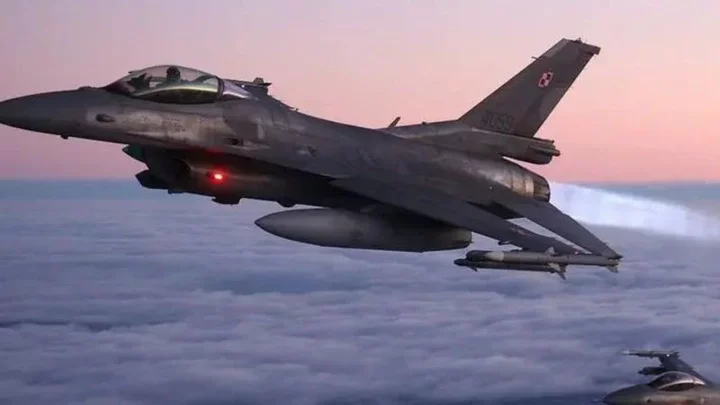
The arrival of export variants of the combat-tested allied variants of the US F-16 fighter jets to Ukraine has been an extremely significant development likely to greatly impact the strategic, tactical, and combat dynamics in the ongoing war.
Many months ago, Deputy Secretary of Defense for Policy Colin Kahl made it clear that Western fighter jets were not "off the table," and sure enough, that is happening now. This is not a moment too soon for supporters of Ukraine, and a Pentagon report says the decision to deliver European F-16 received unanimous international support
As for the decision to support the arrival of European F-16s, Brig. Gen. Pat Ryder said US Defense Secretary Lloyd Austin responded to ongoing requests from Ukraine and its Eastern European allies at the most recent multi-national Ukraine Defense Contact Group.
"He (Austin) subsequently took that matter, introduced it into our national security council policy process as part of a conversation about how we support Ukraine in the mid- to long-term in terms of their defense needs, and there was unanimous agreement that this was something that we should and need to support," Ryder said.
"The fight right now is to ensure that they are able to successfully defend themselves while at the same time taking back sovereign territory," Ryder said in the Pentagon report. "But we look forward to a long-term relationship with Ukraine in terms of their security assistance needs, and again, with the idea here that they can secure their hard-won gains and deter future aggression by Russia."
The full impact of arriving F-16s may reside in a simple numbers question and a question of upgrades. Which variants did Ukraine get?
The Mystery of Ukrainian Air Superiority
The arrival of the F-16 pertains to what could be called the largest "mystery" of the Russia-Ukraine war, which could easily be seen as the continued inability for either military to achieve air superiority in the now year-long conflict.
Any simple look at the numbers shows Russia operates with a massive advantage in terms of pure numbers of fighter jets when compared with Ukraine, yet the Russian military has as of yet not succeeded in achieving air superiority. Why?
Certainly many of the exact reasons may be difficult to specify, as much of Russia's apparent lack of success clearly relates to the sheer tenacity, will, tactical proficiency and fighting intensity of Ukrainians defending their homeland.
Russia's 773 Fighter Jets
At the same time, the discrepancy in numbers is staggering. Global Firepower's 2022 military assessments list Ukraine as operating 69 fighter aircraft, compared with Russia's 773, a disparity one might think would lead to immediate air superiority.
Nonetheless, Ukraine's ability to withstand and even succeed against larger numbers of invading Russian forces would arguably not be possible if Russia did in fact have air superiority.
The US has, for example, massively upgraded its 1980s-era F-15s, F-16s and F/A-18 fighters with new avionics, targeting technologies, sensors and weapons. The Ukrainians have of course been receiving effective air defenses from the West, and they already have been operating a collection of Cold War era Soviet-built SAM systems, the most recent of which is the SA-15 Gauntlet from 1986. How much have these decades old systems been maintained and upgraded?
However, protecting Ukrainian skies with air defenses does not require a massive amount of actual Surface-to-Air-Missile systems, according to former Pentagon Press Secretary John Kirby who told reporters a year ago that a small number of air defenses can protect almost "all of Ukraine."
Russia Operates "Hundreds" of 4th-Gen fighters
Russia operates upgraded 4th-generation Su-35 aircraft as well as Su-30s and Su-35s. Both the Su-34s and Su-35s are cited as "fighter aircraft" emerging as recently as 2014. The Su-34 is listed as a "fighter-bomber" with long-range strike capacity and the Su-35 is reported to be a multi-role heavy combat fighter.
There may be some question as to just how many of these more modern 4th-generation fighters are operational, yet Russia's arsenal of older fighter jets is likely to be larger. Available specs show Russia now operates hundreds of 4th-gen fighter jets, with several of them emerging in only the last ten years. Russia is reported to now operate 6 multi-role MiG-35s which emerged as recently as 2019 and as many as 110 Su-35s from 2013. Russia's MiG-35s are upgraded variants of its large fleet of 240 MiG-29s.
Specs on the MiG-29, published in 2011 by Airforce-technology, show it primarily carries rockets and surface-to-air weapons with some air-to-air possibilities as well. Alongside this payload, the specs also say that the MiG-29 can carry six 1,400 pound-bombs to attack from the sky. Perhaps upgrades in subsequent years enabled this 1980's-era fighter jet to drop precision-guided bombs, however that option may not have been available when the aircraft first took off in 1977.
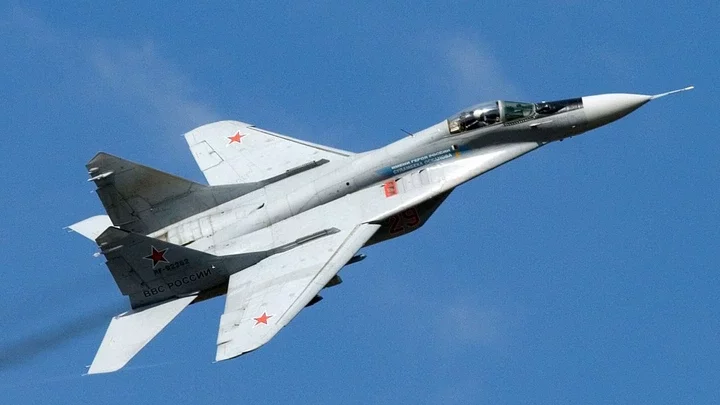
The MiG-29's seven hard points are actually considerably less than the Su-27 fighter which operates with 10-hardpoints and flies at a Mach 2.3 a speed roughly equivalent between the aircraft. Both the Su-27 and MiG-29 aircraft are also comparable with a thrust-to-weight ratio of 1.09.
These differences in external configuration might explain why the Su-27 fuselage wound up evolving into the Su-35, as they are airframes which do appear to succeed in lowering the fighter-jet's radar signature with sloped, slightly blended wing-body configurations.
As for the MiG-29s ability to rival the F-15 and F-16 today, that would seem unlikely unless Russia has been able to sustain the air frame, and to an even greater extent, upgrade the weapons, computing and avionics. The F-15, for example, now has an ultra high speed Advanced Display Core Processor II able to perform billions of calculations per second, AESA radar and new generations of avionics, communications and weapons technology.
Russia's fleet of 1985-era Su-27s is quite large and listed at 359 aircraft, according to a Russian publication listed as The Center for Analysis of World Arms Trade.
Russia's Large Fleet of Su-27s & MiG-29s
Given these statistics, it appears the much heavier payload capacity of the Su-27 might make it the favored aircraft, something which would make sense given that the Su-27 was introduced two years after the MiG-29 in 1983. The largest margin of difference between the two fighters, however, may be in the realm of radar cross section given the configurations shown by each of the images.
The Su-27 has a much more rounded and horizontal fuselage with the exhaust vents not protruding, something which increases the stealth properties of the aircraft. Electromagnetic pings from radar do not, in this case, offer a high-fidelity return rendering. Radar signals cannot "bounce off" flat surfaces to effectively determine the size, shaper and speed of the aircraft. The MiG-29, by contrast has several rectangular-like protruding structures on the back of the aircraft, something much more likely to give radar "pings" something to bounce off of and return to deliver a "rendering" of the aircraft.
Russia's number of 4th-gen aircraft may enable the ability to "mass" or overwhelm enemies in the air. The pertinent question here is .. to what extent have Su-27s been upgraded in a manner similar to the F-16 and F-15? We know that 1980s-era airframes tend to remain viable with some maintenance and structural support, a circumstance which enabled substantial sensing, targeting and weapons technology to be integrated. Today's operational Su-27s are likely to contain upgraded technology not unlike US F-15s and F-16s, making them a significant threat.
Ukraine, by contrast, is reported to operate mostly 1970s and 1980s-era Soviet-built fighter jets such as the Su-24, listed as having emerged as far back as 1974. An older airframe, however, does not necessarily translate into a fighter jet with little capability but rather relies upon the extent of significant upgrades it may incorporate.
Russian 4th-gen vs. Allied F-16s
The US Air Force, for example, has been giving its 1970s-era F-16 fighter F-35 technology as part of a massive fleet-wide overhaul intended to improve targeting, attack precision and computer systems - to extend the fighter's combat life all the way into the 2040s.
It might be tough to imagine that today's Air Force F-16 dates back as far as the 1970s, a circumstance which might lead some to wonder how the combat aircraft has sustained its combat relevance and performance capacity into the dynamic threat environment of the 2020s. The answer is actually quite extensive and goes back many years to the inception and preservation of an F-16 Service Life Extension Program which upgraded the upper wing skin and fittings, adjusted the bulkhead and canopy and gave the aircraft an F-35 Active Electronically Scanned Radar (AESA).
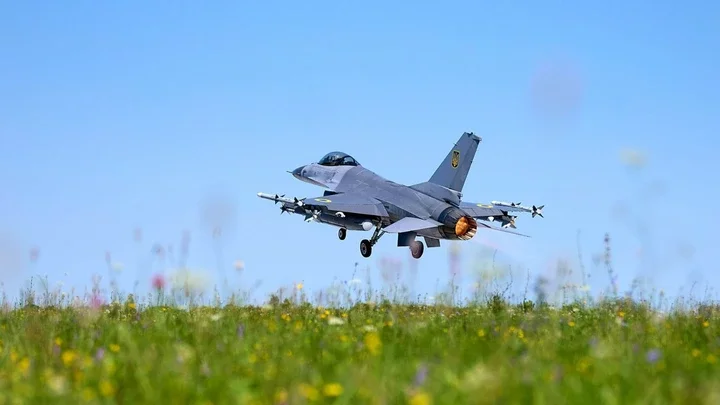
While the Ukrainian F-16s are unlikely to have AESA radar, so the ultimate success of Ukrainian F-16 against Russian forces likely will require successful pilot air-combat tactics, an ability to mass in "networked" formations to blanket areas with air attack, and some degree of upgraded targeting, sensing or attack technology woven into the export variants Ukraine is receiving.
However, Russia continues to massively upgrade its fleet of 4th-generation aircraft as well, and does operate with a significant numbers advantage. With 110 operational Su-35s, its possible some of them incorporate advanced upgrades and newly upgraded Su-35 ++ could be part of the equation.
Dangers of Russian Su-35
The Russian Su-35 could almost be viewed as a quasi-stealthy hybrid mix of advanced fourth-generation fighter jet technology and the early boundaries of what is called 5th-generation. While available specs say Russia operates 110 Su-35, a number which is certainly impactful, it may be unclear just how many of them have already been upgraded with the Su-35 ++ variants. Should Russia have large numbers of upgraded Su-35s, then their inability to achieve air superiority remains even more mysterious, especially given the sheer number of 4th-generation fighters reported to be part of Russia's air fleet.
The Su-35 configuration includes a blended wing-body configuration and horizontal fuselage makes it look stealthier than an F-18 Super Hornet with an almost F-22-like rounded wing-body and dual engine. The Russian Su-35 configuration looks stealthy enough to have potentially inspired designs for the emerging Russian Su-57, a 5th-generation stealth aircraft.
Russian 4th-Gen ++ Su-35
Russia's TASS news agency describes the "heavily upgraded" Su-35S as a maneuverable, multi-purpose fighter jet developed on the "basis of 5th-generation technologies." The "++" refers to new avionics, communications, radar technology, and what the paper calls "plasma ignition engines" to increase thrust vectoring. Much like a 5th-generation jet, the additional thrust vectoring technology enables the Su-35 to achieve supersonic speed without using an afterburner, the paper claims.
This is quite significant as it can of course extend high-speed maneuvers while also supporting longer "dwell time" and attack mission duration in high-threat environments.
This is quite significant and of course raises the question as to whether the upgraded Su-35's existence helped inspire the birth of the U.S. Air Force F-15EX, a platform similarly described by weapons developers as a 4th-generation "Plus" as well. Regarding Ukraine, it seems useful to look quickly at available specs to determine some of the performance parameters likely to impact the outcome should it encounter export variants of the F-16.
Related to this, there is a critical question regarding the kinds of export F-16 variants the Ukrainians will receive. Ryder was clear to avoid specifying which allied countries the F-16s will come from or the particular training locations throughout Eastern Europe, yet Lockheed and the US Air Force have massively upgraded the F-16 in recent years, so it would be extremely relevant to know which of these upgrades may have made their way into export variants of the F-16 for European allies.
The answer to this is likely not available for understandable security reasons, yet it is conceivable that vastly improved F-16s might be part of Ukraine's attack plan. For example, Lockheed has built a special, upgraded F-16 variant for India and has revamped the aircraft considerably for continued relevance in a more significant modern threat environment.
Su-35: Updating to "++"
Additional detail related to the Su-35 specifies that the aircraft uses Passive Electronically Scanned Array radar, a system which essentially tracks and "listens" to threats without emitting a signature itself and giving up its location.
Some of the most specific available research on the Su-35 exists in a 2020 text called "Famous Russian Aircraft - Sukhoi Su-27 and 30/33/34/35," which describes how this cutting edge radar can track an aerial target at ranges up to 250 miles and simultaneously track eight enemy targets at the same time.
The text, written by Yefim Gordon and Dimitry Komissarov, also says the Su-35S is engineered with some "stealthy-like" radar-absorbent materials in specific front-end locations such as the engine inlets and compressor: and other radar cross section reducing technologies.
Gordon's research also points to the aircraft's almost drone-like or surveillance-like capability to use synthetic aperture radar, a technology that bounces electromagnetic "pings" off of the ground or air object to deliver a return "rendering" of threat specifics below.
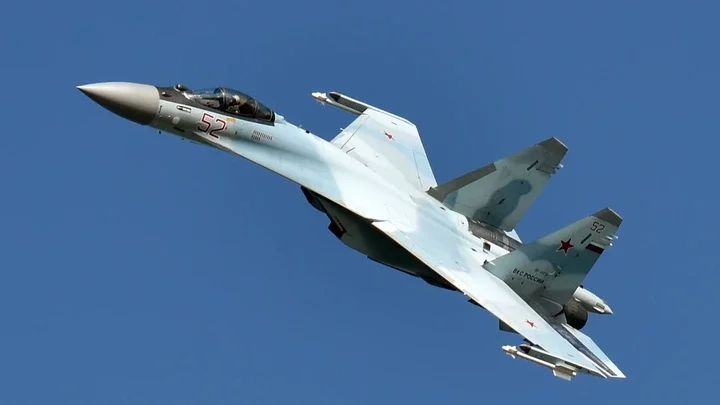
The Su-35 operates with an infra-red search and track targeting system, which, if anything like the U.S. Navy's F/A-18 Super Hornet IRST, improves targeting fidelity and enables operations in a high-threat electronic warfare environment. The 2020 text also cites that the Su-35 is built with electronic countermeasures.
In a more general sense, the TASS article says the aircraft weighs 19-tons, can fly to 20,000 meters, and hits a maximum speed of Mach 2.25. After emerging as an upgraded Su-27 in 2014, the Su-35 still flies today and, should the research be accurate, it seems it could potentially rival the U.S. F-15EX
One factor, as described by Senior Pentagon officials briefing reports on the conflict is that Russia has appeared to be "risk-averse" meaning its pilots are showing a reluctance to operate in high threat areas where Ukrainians have air defenses. Perhaps Ukraine's air-defences are extremely effective or at least quite threatening such that larger formations of Russian aircraft have been hesitant to attack.
One possible explanation for this is that Russia has been destroying Ukrainian targets and civilian neighborhoods with long-range, ground fired rockets able to travel 200 to 300 miles in some cases. This is something the Ukrainians previously had trouble stopping due to an inability to target them from the air. However, the arrival of HIMARS and GMLRS long-range ground rockets have enabled the Ukrainians to attack Russian missile and rocket launch areas deeper within Russia.
The Russian 4th-generation Su-35 aircraft came to life as a result of years of upgrades to the Su-27 air defense fighter. With high speeds of Mach 2.25, the Su-35 looks well-positioned to dogfight and vector in the air as a air-to-air supremacy fighter, yet it would seem unlikely that the aircraft would rival an F-22. However, the configuration of the Su-35 appears to the observer's eye to contain similarities to the F-22 and some of the listed weapons specs are comparable.
Can Russia's Su-35 Challenge the F-22? Defeat F-16s?
While no F-22s are operating in Ukraine, as that is a uniquely cherished US Air Force platform which has not been exported, it may prove useful to examine some of the key ways in which Su-35s might rival or outmatch other fighters such as the F-22 or the F-16s it is likely to face.
Available specs on the two aircraft suggest they are comparable in terms of speed, as both the F-22 and Su-35 are listed as capable of flying Mach 2.25 at altitude. Also, while this may not be verifiable to a certain extent, a Russian-language newspaper called Hoboctn BNK claims the Su-35 has an F-22-like "supercruise" ability to maintain Mach-speeds without needing afterburner.
The most surprising point of Su-35 vs F-22 comparison, however, can be seen in thrust to weight ratio. A data chart published in the Russia Defence Forum says the Su-35 has a higher thrust-to-weight ratio when compared to an F-22.
The Su-35 tops the chart with a 1.30 thrust to weight ratio, whereas the F-22 is listed as 1.18 or as high as 1.37 with round nozzles, according to the chart provided. While both the F-22 and the Su-35 can take off vertically and accelerate, does the Su-35 out-perform an F-22 in terms of purse thrust, acceleration and thrust at a high rate of climb? At very least the two aircraft may be comparable, a significant observation given that the F-22 is widely referred to as the world's best air-dominance fighter jet.
The real difference between the two aircraft then, it would seem, might pertain to their respective ability to vector and maneuver at high speeds in an air-engagement. Also, the question of which plane might prevail in a dogfight becomes less relevant if one of the fighters has superior sensing, radar, targeting and weapons guidance, areas which are most likely to determine the real margin of difference.

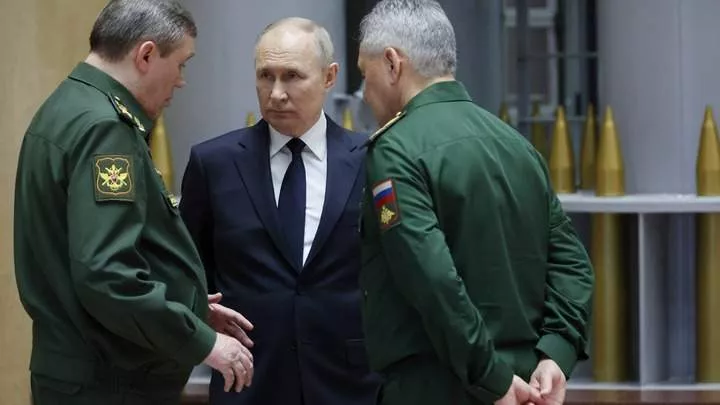
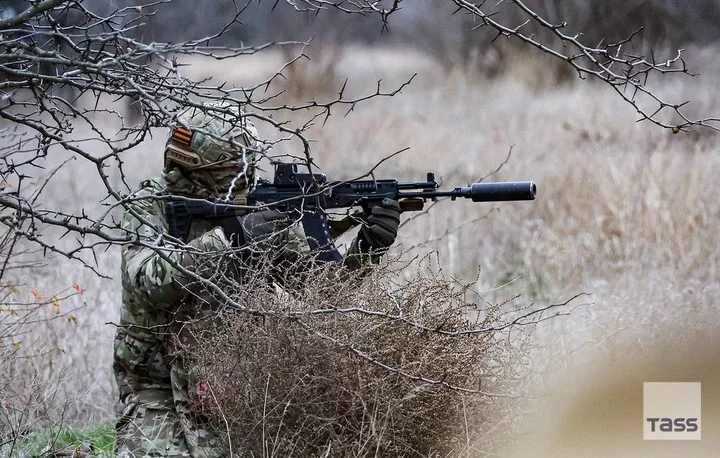













Comments